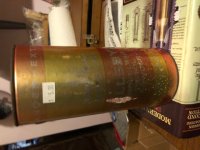Yep. It's unpredictable because the canister grades sold to handloaders have to have a tighter burn rate spec than the bulk grade does. This is because the canister grades are meant to be loaded from recipes. The bulk grades are used by commercial ammunition makers who have pressure test guns to adjust the charge with, so they don't care if the recipe isn't the same from one lot to the next. The canister grades are made from bulk grade powder by blending a bulk lot with held-back prior lots of the same powder that came out burning faster or slower, depending in which direction they need to move the burn rate to make it valid for recipes. Unfortunately, that gives the handloader a combination of two powders, one of which we have no idea of the age for. So, you might be lucky and get a lot that happened to come out at the right burn rate and was never blended and which can be expected to last well, but sometimes you get a lot that was blended with a pretty old lot and that can go bad prematurely. This is what a goodly portion of powder recalls seem to be about.
Norma says you can count on their powders to last 10 years. The military stores munitions made from the unblended bulk grade powders 45 years for single-base powders and 20 years for double-base powders, at which point the ammunition is surplused out and pulled down and sold to you on the hope it will last longer.
As mentioned, heat is the enemy. U.S. Naval Ordnance and the U.S. Army Ordnance departments have both had researchers destroy powder in under two years by subjecting it to temperatures ranging from 140°F (18 months to going bad) to 160°F (six months to a year). Your best bet is to seal the powder in a freezer bag and put it in the deep freeze, where it will last longer than you will. You just have to be careful that when you pull it out to use it, you give it plenty of time to reach room temperature before you open the bag.

